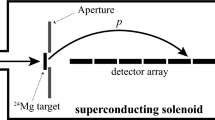Abstract
Purpose
Cosmogenic isotopes, known for their diverse types and relatively long lifetimes, are frequently treated as significant backgrounds in neutrino experiments. Particularly in the correlation events of inverse beta decay (IBD) events of reactor neutrinos, addressing and removing \(^{9}\)Li and \(^{8}\)He background is necessary. Similarly, for elastic scattering (ES) events of solar neutrinos, isotopes such as \(^{12}\)B and \(^{8}\)Li have significant impacts. This study aims to identify an appropriate method for reducing the backgrounds in neutrino experiments.
Methods
In this paper, we conducted simulations of muon backgrounds in a liquid scintillator detector using Geant4 and explored the correlation between cosmogenic isotopes and muons. We introduced a novel method to distinguish cosmogenic isotopes from neutrino signals. Utilizing the relationship between the distance and time of spallation isotopes to muons and neutrons, we employed the TMVA (tools for multi-variable analysis) to distinguish neutrino signals from isotope backgrounds, achieving good performance.
Results
Compared with the traditional veto method, the efficiency has been improved by 1% for correlated events and 18% for single-event signals at the same background level.
Conclusion
This study presents a novel method for discriminating cosmogenic isotopic backgrounds, achieving a higher signal-to-noise ratio compared to traditional approaches, and showing good potential applicability to similar analyses in the future.
















Similar content being viewed by others
References
Q.R. Ahmad et al., SNO. Phys. Rev. Lett. 89, 011301 (2002)
C.L. Cowan et al., Science 124, 103–104 (1956)
A.M. Serenelli, W.C. Haxton, C. Pena-Garay, Astrophys. J. 743, 24 (2011)
A. Abusleme et al., JUNO. Chin. Phys. C 45(2), 023004 (2021)
J.F. Beacom et al., Jinping. Chin. Phys. C 41(2), 023002 (2017)
F. An et al., JUNO. J. Phys. G 43(3), 030401 (2016)
G. Bellini et al., Borexino. Phys. Rev. D 89(11), 112007 (2014)
X. Guo et al., Daya Bay, [arXiv:hep-ex/0701029 [hep-ex]]
J.K. Ahn et al., RENO. Phys. Rev. Lett. 108, 191802 (2012)
Y. Abe et al., Double Chooz. Nucl. Instrum. Meth. A 764, 330–339 (2014)
H. Back et al., Borexino. Phys. Rev. C 74, 045805 (2006)
S. Locke et al., Super-Kamiokande, [arXiv:2112.00092 [hep-ex]]
A. Hocker et al., TMVA, [arXiv:physics/0703039 [physics.data-an]]
S. Agostinelli et al., GEANT4. Nucl. Instrum. Meth. A 506, 250–303 (2003)
J. Allison et al., GEANT4. IEEE Trans. Nucl. Sci. 53, 270 (2006)
J. Allison et al., GEANT4. Nucl. Instrum. Meth. A 835, 186–225 (2016)
S. Abe et al., KamLAND. Phys. Rev. C 81, 025807 (2010)
G. Bellini et al., Borexino. Phys. Rev. D 82, 033006 (2010)
A. Abusleme et al., JUNO. Chin. Phys. C 46(12), 123001 (2022)
Author information
Authors and Affiliations
Corresponding author
Ethics declarations
Conflict of interest
All authors have no conflict of interest. On behalf of all authors, the corresponding author states that there is no conflict of interest.
Rights and permissions
Springer Nature or its licensor (e.g. a society or other partner) holds exclusive rights to this article under a publishing agreement with the author(s) or other rightsholder(s); author self-archiving of the accepted manuscript version of this article is solely governed by the terms of such publishing agreement and applicable law.
About this article
Cite this article
Zhang, X., Lu, H., Yang, C. et al. A novel discrimination method for neutrinos and cosmogenic isotopes in liquid scintillator-based detectors. Radiat Detect Technol Methods (2024). https://doi.org/10.1007/s41605-024-00469-6
Received:
Revised:
Accepted:
Published:
DOI: https://doi.org/10.1007/s41605-024-00469-6




